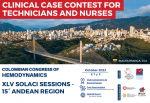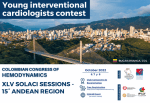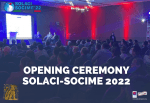Send Your Case Call for Case Submission XLV SOLACI Regional Sessions – 15° Andean Region. October 6, 7 & 8, 2022 | Bucaramanga – Colombia. We invited all nurses and technicians in LATAM to present their clinical cases of interest to the next SOLACI Sessions – Colombia 2022, to be held on October 6, 7...
Colombia Sessions 2022 | Clinical Case Contest for Young Interventionists
The contest ended. The authors of the selected cases for live presentation have been contacted by email Call for Case Submission XLV SOLACI Regional Sessions – 15° Andean Region. October 6, 7 & 8, 2022 | Bucaramanga – Colombia. It is with great pleasure that we hereby invite all young Latin American cardiologists to submit...
The Best of the SOLACI-SOCIME 2022 Main Arena: Day 3
Lecture by Dr. Hector García García – LM-PCI: IVUS and FFR/IFR? Dr. Hector García delivered an excellent presentation on whether we should use intravascular ultrasound (IVUS) or fractional flow reserve (FFR)/instantaneous wave-free ratio (iFR) in the left main coronary artery (LMCA) to consider severe obstruction, since there is significant interobserver variability with angiography. Although the...
SOLACI and SOCIME Celebrated Returning to Face to Face during Congress Opening Ceremony
SOLACI Congress is back! Before a full hall, SOLACI and SOCIMIE authorities celebrated the return to face to face during the opening ceremony of SOLACI-SOCIME 2022, which started with the presentations of 3 opinion leaders, namely Ole de Backer (DNK), Juan Granada (USA) and Alain Cribier (FRN). In this context, the President of the Latin...
The Best of the SOLACI-SOCIME 2022 Main Arena: New Paradigms in Angioplasty
“New Paradigms in Angioplasty,” by Dr. Gregg Stone While most studies on angioplasty in stable coronary artery disease have shown an improvement in angina frequency and exercise capacity, there is no significant reduction in death and acute myocardial infarction (AMI). Currently, one of the main factors is the definition of vulnerable plaque, because it is...
The 12th Edition of ProEducar-SOLACI Fellows Course Was Held
Amidst the 27th annual meeting of the Latin American Society of Interventional Cardiology and the annual meeting of the Mexican Society of Interventional Cardiology, the 12th edition of our course for fellow interventionists ProEducar was held. The course – directed by Dr. Leandro Lasave (ARG) and codirected by Drs. Gabriel Maluenda (CHL), Guering Eid Lidt...
DISRUPT-PAD III: Followup of IVL Treatment in Femoropopliteal Territory
Femoropopliteal segment calcification can generate complications for both preparation and execution of endovascular therapies for patients with peripheral artery disease. It can produce suboptimal vessel expansion associated to higher risk of dissection or perforation. These adverse effects can affect procedure durability in the long term. Studies on the use of drug coated balloons to treat...
Are Elevated Lipoprotein (a) Levels Associated with Increased Adverse Events After Peripheral Endovascular Treatment?
Peripheral arterial disease is a manifestation of systemic atherosclerotic disease with increasing prevalence. Moreover, this disease is associated with a high risk of mortality and cardiovascular events. Lipoprotein (a) (Lp a)—which has a proatherogenic, proinflammatory, and antifibrinolytic role—has been shown to be related to major cardiovascular events and peripheral vascular events after acute coronary syndromes...
Longitudinal Deformation of a Stent with the POT Technique
The fractal geometry of coronary bifurcations offers a mismatch between the proximal diameter of the main branch and the distal branches that make up the bifurcation. Angioplasty in this area can be performed through different techniques depending on plaque distribution, and the particular geometry of each bifurcation. Overall, and regardless of the strategy used, there...
Coronary Physiology Is Useful in Chronic Kidney Disease
Coronary physiology, FFR and iFR, has been shown safe to defer lesions and effective to save stents by different randomized studies and registries. However, patients with chronic kidney disease have not been thoroughly analyzed yet, which brings us to the question about what to do in the face of their negative evolution, when atherosclerosis develops...









